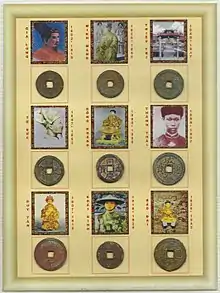Vietnamese văn (currency unit)
The Vietnamese văn (Hán tự: 文; French: Sapèque) as a denomination for Vietnamese cash coins was used from 1868 until 1885 during the reign of the Nguyễn dynasty (but appeared on cash coins until 1945). The inspiration to introduce the văn may have been to emulate the Chinese wén used on contemporary Qing dynasty cash coins which had just become a fiat currency, however unlike the Chinese system where all Chinese cash coins were cast from the same metals the and the wén was the primary unit of account, the Vietnamese system used the văn as a basic number currency symbol indicating how much zinc cash coins a brass cash coin was worth, while it used the mạch (陌) and quán (貫) as units of account. It was abolished as a measurement for zinc cash coins when the French Indochinese piastre was introduced,[1] after which the term still appeared on Vietnamese cash coins but represented a subdivision of the piastre known in French as sapèque as the production of zinc coinage was ceased by the Imperial government of the Nguyễn dynasty around the year 1871.[2]
_%2526_T%E1%BB%B1_%C4%90%E1%BB%A9c_Th%C3%B4ng_B%E1%BA%A3o_(%E5%97%A3%E5%BE%B7%E9%80%9A%E5%AF%B6)_-_Scan_01.png.webp)
The French sapèque was worth 1⁄600 of a piastre (a currency based on the Mexican peso) and represented Vietnamese cash coins in general.[3] The Vietnamese term văn (文) would appear on the Thành Thái Thông Bảo (成泰通寶), Duy Tân Thông Bảo (維新通寶), and Bảo Đại Thông Bảo (保大通寶) cash coins produced under French rule, the last of these was officially produced until 1945.[4][5]
History
_-_Art-Hanoi_06.jpg.webp)
It first used by official decree in January 1868 during the reign of the Tự Đức Emperor which decreed that "the value of the large module copper cash coin passed to 6 (zinc) and the small copper coin to 4 zinc". In 1872 the first brass Tự Đức Thông Bảo (嗣德通寶) cash coins with the monetary unit văn were cast in Hanoi, these cash coins has weight of 7 phần and had the reverse inscription "Lục Văn" (六文) on them indicating that these coins were worth 6 zinc cash coins. The introduction of this new currency symbol marked the change in the relationship between Vietnamese cash coins made from copper and cash coins of zinc and it de facto increased the value of the Vietnamese brass cash currency. In November 1879 the official value of 6 copper phần was equal to 6 sapèques of zinc. However the foreign cash coinages as well as imitation (counterfeit) Vietnamese cash coins made of inferior alloys that circulated in Vietnam at the time were exchanged for only 3 cash coins of zinc.[6]
In the year 1893, large brass Thành Thái Thông Bảo (成泰通寶) cash coins with a denomination of 10 văn (十文, thập văn), or 10 zinc cash coins, started being produced by the Huế Mint.[7]
References
- Jean-Pascal Bassino and Hironobu Nakagawa, Exchange Rates and Exchange Rate Policies in Vietnam Under French Rule, 1878-1945
- "Sapeque and Sapeque-Like Coins in Cochinchina and Indochina (交趾支那和印度支那穿孔錢幣)". Howard A. Daniel III (The Journal of East Asian Numismatics – Second issue). 20 April 2016. Retrieved 4 March 2018.
- [email protected] (29 December 2015). "Saigon-Cholon in 1868, by Charles Lemire". First published in the 1869 journal Annales des voyages, de la géographie, de l’histoire et de l’archéologie, edited by Victor-Adolphe Malte-Brun, Charles Lemire’s article “Coup d’oeil sur la Cochinchine Française et le Cambodge” gives us a fascinating portrait of Saigon-Chợ Lớn less than 10 years after the arrival of the French. Retrieved 4 March 2019.
- French Southeast Asia Coins & Currency by Howard A. Daniel III (page 97).
- 保大 Bảo Đại 1926-1945 cash coins By Sema (Art-Hanoi) Cash coins of Bao Dai were the last cash-style coins produced in the world. Retrieved: 19 March 2019
- Art-Hanoi CURRENCY TYPES AND THEIR FACE VALUES DURING THE TỰ ĐỨC ERA. This is a translation of the article “Monnaies et circulation monetairé au Vietnam dans l’ère Tự Đức (1848-1883) by Francois Thierry Published in Revue Numismatique 1999 (volume # 154). Pgs 267-313. This translation is from pages 274-297. Translator: Craig Greenbaum. Retrieved: 19 March 2019.
- François Thierry de Crussol (蒂埃里) (14 September 2015). "Bas monnayage de Thành Thái 成泰 (1889-1907) - Brass coinage of Thành Thái era (1889-1907)" (in French). TransAsiart. Retrieved 26 April 2020.
Sources
- Eduardo Toda y Güell (1882) ANNAM and its minor currency. Hosted on Art-Hanoi. (Wikimedia Commons)
- Dr. R. Allan Barker. (2004) The historical Cash Coins of Viet Nam. ISBN 981-05-2300-9
| Wikimedia Commons has media related to Văn (currency unit). |


_-_Art-Hanoi_01.jpg.webp)
_Art-Hanoi_02.jpg.webp)
_02.jpg.webp)